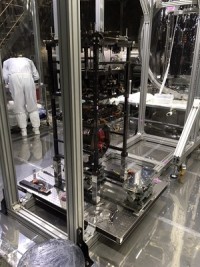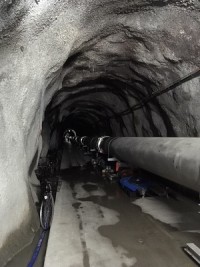
Tunnel vision: entry point to the KAGRA gravitational-wave observatory in Kamioka. (Courtesy: Michael Banks)
By Michael Banks in Kamioka, Japan
Of all the places I have been, I can’t remember being asked to ride a bicycle for 3 km down a dimly lit tunnel that had water dripping – sometimes pouring – from the ceiling.
But that’s what happened today when I visited the KAGRA gravitational-wave observatory in northern Japan.
Rising bright and early – a common occurrence this week thanks to jet lag – I took the Shinkansen from Tokyo to Toyama.
Around an hour south of Toyama is the small village of Kamioka that is home to KAGRA as well as the nearby SuperKamiokande neutrino observatory.

KAGRA’s polished sapphire mirror (courtesy: Michael Banks)
Kamioka certainly feels remote being in a valley surrounded by mountains on all sides. Indeed, at this time of year the views are spectacular as the leaves on the trees on the slopes of the mountain turn a mixture of red, brown and yellow.
I was shown around KAGRA by Shinji Miyoki from the Institute for Cosmic Ray Research at the University of Tokyo.
I jumped in his car and we drove to the entrance of a 500 m-long tunnel in the side of a mountain. It all felt slightly low key given that this will soon be home to one of the world’s most advanced gravitational-wave observatories.
Construction of KAGRA began in 2010 and is set to be complete in March 2019. It is a huge interferometer in which a 2 W laser beam is split down two 3 km-long arms. The beams are reflected multiple times between mirrors suspended at the ends of each arm and then combined at a detector. A gravitational wave is a ripple in space–time and when it passes through an interferometer, it can change the distances between the mirrors. This is detected as a change in how the laser light interferes at the detector.
While the advanced Laser Interferometer Gravitational-wave Observatory (aLIGO) in the US already detected gravitational waves for the first time in 2015, that hasn’t stopped Japan forging ahead with their own observatory.
Indeed, the Japanese design has some key differences. One is that the mirrors -a single-crystal of sapphire weighing 23 kg – are cooled to around 10 K to reduce thermal noise. The second is that the facility is built some 200 m underground to help reduce seismic noise.

On your bike: cycling is one way to get to the end of KAGRA’s 3 km arms (courtesy: Michael Banks)
Yet despite these advantages both aLIGO and KAGRA will still have similar sensitivity, thanks in part to LIGO’s greater size with 4 km-long arms.
Currently, engineers at KAGRA are testing the sapphire mirrors that will be placed at each end of KAGRA’s arms and during the tour, Miyoki asked whether I would like to see a mirror.
However, I didn’t quite realise what that would involve. As KAGRA is still very much under construction, getting there involved traversing beampipes, both ducking under and even walking on.
That was then followed by a 3 km cycle to the end of the arm. While the ride made me appreciate how big this facility is, it would have been a more pleasant experience if I was trying to not to get drenched or worse fall off the bike.
Yet I survived and managed to catch a glimpse of the mirror before it is soon placed in the cryostat.
Once above ground, I asked Miyoki whether Japanese researchers are disappointed to have missed the party when it came to the first detection of gravitational waves. “We were incredibly pleased for LIGO,” says Miyoki. “It makes it exciting for the future.”
Trackback: สว่านไฟฟ้า สว่านไฟฟ้าไร้สาย เครื่องขัดกระดาษทราย เครื่องตัด เครื่องฉีดน้ำพลังสูง เครื่อง